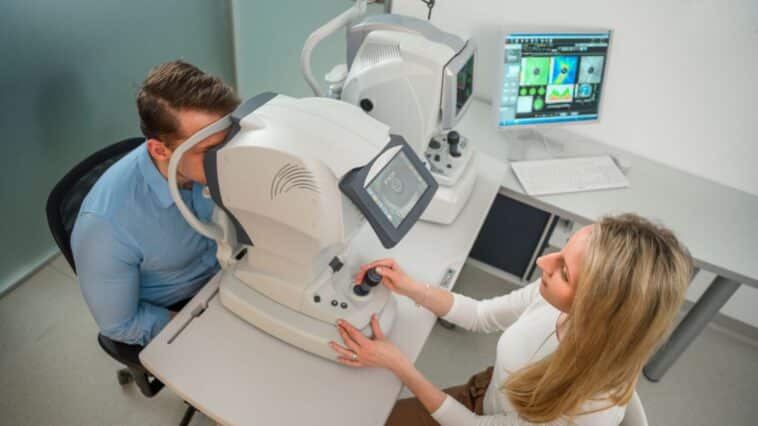Myopia, commonly known as nearsightedness, affects millions worldwide. Among its variations, high myopia poses unique challenges and risks. This article delves into the intricacies of high myopia, its causes, associated complications, and effective management strategies.
Causes and Risk Factors
High myopia is a condition characterized by a significant degree of refractive error, leading to blurred distance vision and potential ocular complications. Several factors contribute to the development of high myopia, and understanding these causes and risk factors is crucial for prevention, early intervention, and effective management.
Early Onset of Myopia: One of the primary risk factors for high myopia is an early onset of myopia during childhood or adolescence. When myopia starts at a young age, the progression over time can result in a higher degree of refractive error. Children diagnosed with myopia at an early age are at a greater risk of developing high myopia later in life.
Genetic Predisposition: Family history plays a significant role in developing high myopia. If one or both parents have high myopia, their children are more likely to inherit the genetic predisposition for the condition. Genetic factors influence the structural characteristics of the eye, such as the length of the eyeball, which contributes to the severity of myopia.
Environmental Factors: Environmental factors also contribute to the risk of high myopia. Excessive near work, such as prolonged reading or screen time, can strain the eyes and contribute to myopia progression. Additionally, limited outdoor time and exposure to natural light during childhood have been associated with a higher risk of myopia development, including high myopia.
Lack of Outdoor Activities: Spending time outdoors, especially in natural daylight, has been shown to protect against myopia development. Children who engage in outdoor activities have a lower risk of developing myopia and progressing to high myopia. Sunlight exposure and visual stimuli outdoors play a role in regulating eye growth and preventing excessive elongation of the eyeball.
Near Work and Screen Time: Engaging in activities that require prolonged near focus, such as reading, using digital devices, and studying, can contribute to the progression of myopia. This is especially relevant for individuals with a genetic predisposition. Managing screen time and taking regular breaks to look at distant objects can help reduce the strain on the eyes.
Lack of Proper Eye Care: Regular eye examinations can maintain the diagnosis of myopia and its progression. Early intervention through eye exams allows optometrists and ophthalmologists to monitor refractive changes, prescribe appropriate corrective measures, and implement myopia control strategies to prevent the development of high myopia.
Ethnicity and Geographic Location: Certain ethnic groups and geographic locations have a higher prevalence of myopia, including high myopia. Asian populations, for example, often exhibit higher rates of myopia and severe forms of myopia. These regions ‘ genetic factors and environmental influences can increase risk.
Complications of High Myopia
High myopia, characterized by a significant degree of nearsightedness, poses various complications that can impact vision and eye health. Recognizing the signs of high myopia is essential for timely intervention and management.
Retinal Detachment and Tears: One of the most serious complications of high myopia is an increased risk of retinal detachment and tears. The elongation of the eyeball in high myopia can lead to thinning of the retina, making it more susceptible to detachment or tears. If not promptly treated, retinal detachment can result in permanent vision loss.
Cataracts: High myopia is associated with an earlier onset of cataracts, clouding the eye’s natural lens. Cataracts can lead to blurred vision and glare, affecting both near and distant vision. Individuals with high myopia may experience cataracts at a younger age compared to those without myopia.
Glaucoma: High myopia increases the risk of developing certain types of glaucoma, a group of eye conditions that damage the optic nerve and can lead to vision loss. The elongation of the eyeball in high myopia can cause changes in the angle of the eye’s drainage system, contributing to glaucoma development.
Posterior Vitreous Detachment: Posterior vitreous detachment (PVD) occurs whee the gel-like substance within the eye’s vitreous humor separates from the retina. In high myopia, the elongated eyeball can make the vitreous more likely to detach, which may cause floaters, flashes of light, and, in rare cases, retinal tears.
Optic Neuropathy: High myopia can also increase the risk of optic neuropathy, a condition where the optic nerve is damaged, leading to vision impairment. This damage can result from various factors, including glaucoma and retinal detachment, which are more prevalent in individuals with high myopia.
Identifying High Myopia
Diagnosing High Myopia: High myopia is diagnosed based on the refractive error determined during an eye examination. If the prescription is significantly negative (e.g., -6.00 D or greater), it indicates the presence of high myopia. Regular eye exams, especially for individuals with a family history of myopia, are essential for early detection and intervention.
Eye Exams and Screening: Comprehensive eye exams are pivotal in identifying high myopia. These exams include various tests such as visual acuity assessment, refraction measurement, and a dilated fundus examination to evaluate the health of the retina and optic nerve. Regular eye exams are crucial for children and adolescents to monitor myopia progression and implement appropriate interventions.
Regular eye exams and screenings are vital for identifying high myopia and implementing strategies to mitigate its impact on vision and overall eye health.
Strategies for Managing High Myopia
High myopia comes with unique challenges, but effective strategies and interventions exist to manage its progression and reduce the risk of complications. By combining myopia control measures with lifestyle adjustments, individuals with high myopia can take charge of their eye health and preserve their vision for the long term.
Eyeglasses and Contact Lenses: Prescription and contact lenses are fundamental for correcting vision in individuals with high myopia. High-index lenses may be recommended to reduce lens thickness and improve comfort. Additionally, specially designed multifocal or orthokeratology contact lenses can help control myopia progression.
Atropine Eye Drops: Atropine eye drops, in low concentrations, have shown promise in slowing down myopia progression. They work by temporarily relaxing the focusing mechanism of the eye. While more research is needed to determine the long-term effects, they are considered a viable option for myopia control.
Orthokeratology: Orthokeratology involves wearing specially designed rigid contact lenses overnight to reshape the cornea temporarily. This can lead to clearer vision during the day without needing glasses or contacts. It has been shown to slow the progression of myopia, making it a popular choice for individuals with high myopia.
Lifestyle Changes for Myopia Management
Outdoor Time and Natural Light Exposure: Increasing time spent outdoors, especially in natural daylight, has been linked to a reduced risk of myopia progression. Encourage outdoor activities and playtime, as exposure to natural light has a protective effect on the eyes.
Screen Time Guidelines: Limiting screen time, especially close-up digital device use, can alleviate eye strain and reduce the risk of myopia progression. Adhering to recommended screen time guidelines, particularly for children, can improve eye health.
Visual Breaks and Eye Exercises: Practicing the 20-20-20 rule—taking a 20-second break to look at something 20 feet away every 20 minutes—can alleviate eye strain during prolonged near work. Incorporating simple eye exercises can also help maintain visual flexibility and reduce discomfort.
Nutritional Considerations: A balanced diet of vitamins A, C, and omega-3 fatty acids can support overall eye health. These nutrients contribute to the maintenance of healthy retinal tissue and visual function.
Early Intervention and Prevention
Importance of Detecting High Myopia Early: Early detection is essential for effective management. Regular eye exams, especially for children and adolescents, can identify myopia progression and allow for timely intervention.
Myopia Management for Children and Adolescents: Children and adolescents with high myopia benefit significantly from myopia control strategies. Orthokeratology, atropine drops, and multifocal contact lenses are tailored to slow progression during critical growth.
Taking an active role in managing high myopia can significantly impact maintaining clear vision and reducing the risk of complications. Individuals can optimize their eye health and quality of life by combining myopia control measures, lifestyle changes, and early intervention. Always consult an eye care professional to determine the most suitable strategies for your situation.
Conclusion
High myopia presents challenges, but its impact can be managed with knowledge and action. Key takeaways:
- High myopia brings complications like retinal issues and glaucoma.
- Strategies like myopia control measures and lifestyle changes can slow progression.
- Early intervention and expert advice are crucial for managing risks.
- Your commitment to proactive management paves the way for a clearer vision.
- Stay informed, seek guidance, and take control of your eye health.
Understanding and addressing high myopia means investing in a future with better sight and enhanced well-being.






